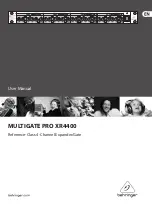
10
MULTIGATE PRO XR4400 User Manual
The following chapter describes the interactive control functions in full detail:
5.2.1 THRESHOLD control
The THRESHOLD control determines the threshold point and disables the
respective channel. As it covers a very wide setting range it can be easily adapted
to any operating level:
Input levels above the adjusted threshold point pass the circuit unprocessed.
However, as soon as the input signal drops below the threshold, dynamics
processing sets on. Simple noise gates usually have a control to set the switch-on
and switch-off thresholds, but must perform their task without any dedicated
control elements that allow for varying the envelopes.
The BEHRINGER MULTIGATE PRO, however, is equipped with all necessary control
options. The following section makes clear why it is so important to be able to
adjust these parameters.
5.2.2 Attack, release and hold times
The BEHRINGER MULTIGATE PRO is equipped with a MODE switch as well as a
HOLD and RELEASE control to adjust the time-domain parameters that determine
the so-called envelope:
amplitude
attack
hold
release
time
max.
0
Fig. 6.2: Principle of envelope function
Attack time
The quality of an expander/gate is largely determined by the speed of its attack
function (rise time). This parameter defines the time the expander needs after
the signal has passed the threshold to recover from the applied gain reduction,
i.e. to reverse the control process.
Extremely short transients (level peaks) such as hand claps and percussive
instruments, etc. require an extremely short attack time to prevent the expander
from cutting the signal flanks and thus deteriorating the sound.
The new BEHRINGER-developed UTR circuit (Ultra Transient Response)
in combination with a high-grade VCA allows for an extremely short response
time in gate mode, without audible switching noise as it is generated by many
conventional designs.
Release time
Another important parameter is the release time, as it determines the time the
gate needs to reduce the signal level by a certain amount, after the signal has
dropped below the threshold.
Hold time
The hold-time parameter enables you to delay the starting point of the release
process. In particular, when processing frequently interrupted signals such as
vocals, an additional hold-time parameter is indispensable to prevent the gate
from switching off and back on during signal pauses.
5.2.3 IAC circuit (Interactive Attack Control)
The MULTIGATE PRO features an IAC circuit (Interactive Attack Control)
which analyzes the program material to calculate the attack time by way of
interaction, so that the hold/release process is triggered automatically depending
on the program material. This is the reason why the MULTIGATE PRO does not
need a dedicated attack control.
5.2.4 RANGE function
On the MULTIGATE PRO the dynamic processing is controlled by a high-grade
VCA with a working range of more than 100 dB, i.e. the input signal can be
reduced in level by as much as 100 dB.
For most applications, however, it is neither desirable nor necessary to cut
the signal completely after it has dropped below the threshold. In particular,
when processing signals with lots of background noise, this would result in
abrupt and audible control processes that are less likely to enhance the overall
sound quality.
For this reason, the MULTIGATE PRO is equipped with a RANGE control that
allows you to limit the maximum gain reduction applied. Thus, you can use
smaller amounts of gain reduction making it possible to retain the natural sound
of the program material—in particular, with signals that contain plenty of
interference noise.
5.2.5 IRC circuit (Interactive Ratio Control)
In conventional expanders the control processes cut the signal abruptly below
the threshold, which usually leads to less satisfying results, because the onset
of the control function becomes audible. When inaudible expansion is needed,
it is therefore better to use a “soft-knee” characteristic around the threshold
point that allows for a smoother transition.
The BEHRINGER MULTIGATE PRO uses the newly developed IRC expander
(Interactive Ratio Control) whose attack time and ratio characteristics vary
automatically depending on the program material.
The IRC expander is switched on with the MODE switch. Low ratios and hence
subtle expansion produce a “smooth” transition, while higher ratios and heavy
expansion result in a “steeper” transition between the characteristic curves.
This so-called interactive, i.e. nonlinear IRC characteristic is perfectly adapted
to human hearing: critical wanted signals around the threshold point are less
expanded, while interference signals with lower levels (e.g. background noise)
are processed and faded out with a higher expansion ratio.

































